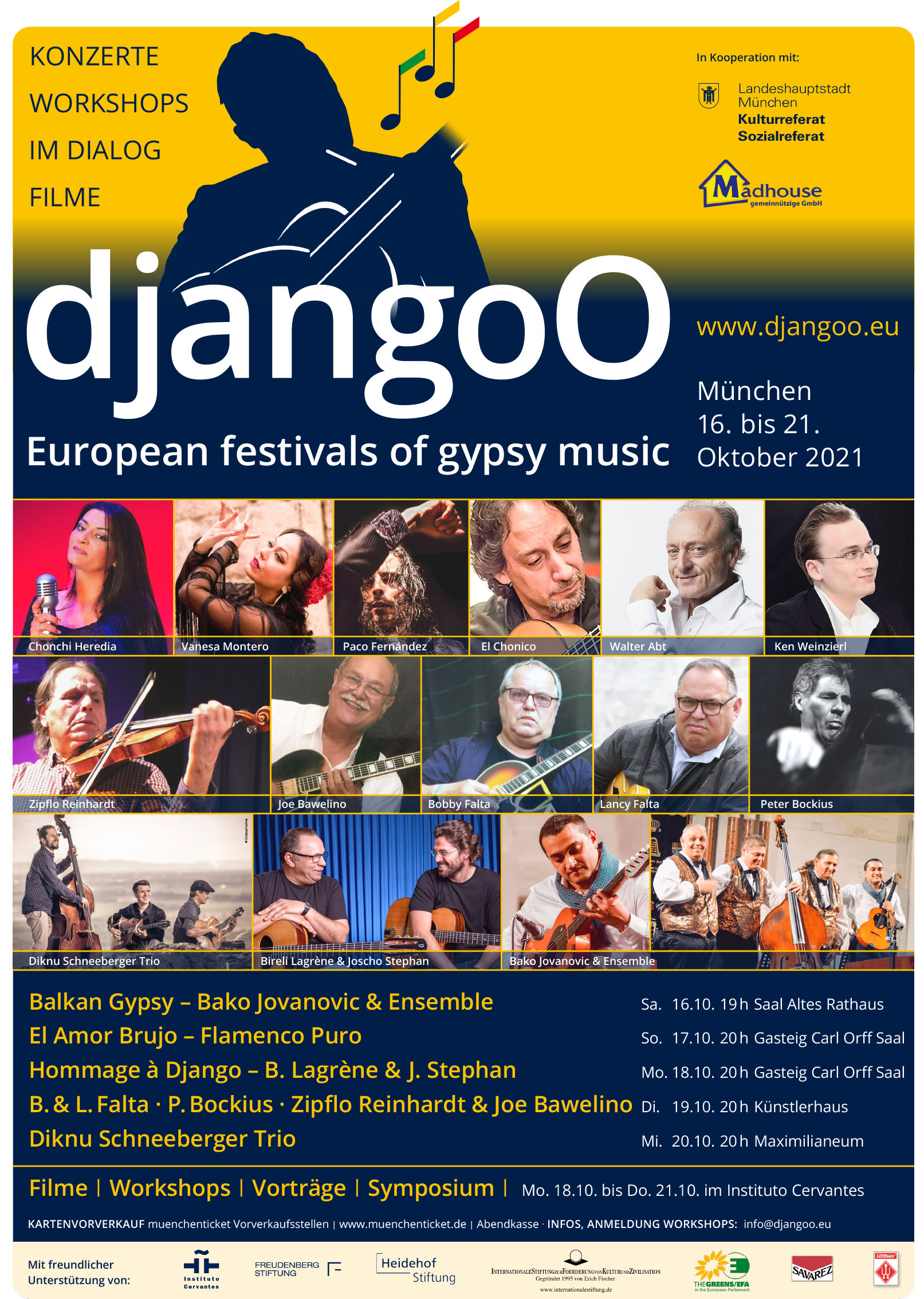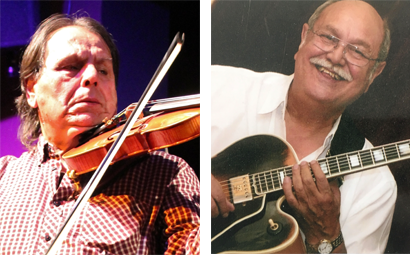
djangoO
European Festival of Gypsy Music
Gypsy Highlights: 28.+29.10.2023, Künstlerhaus am Lenbachplatz, Munich
djangoO 2021

Walter Abt
Artistic Director
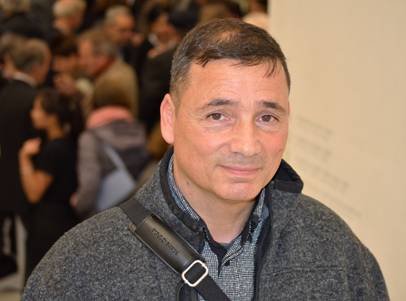
Alexander Diepold
Head of Organization
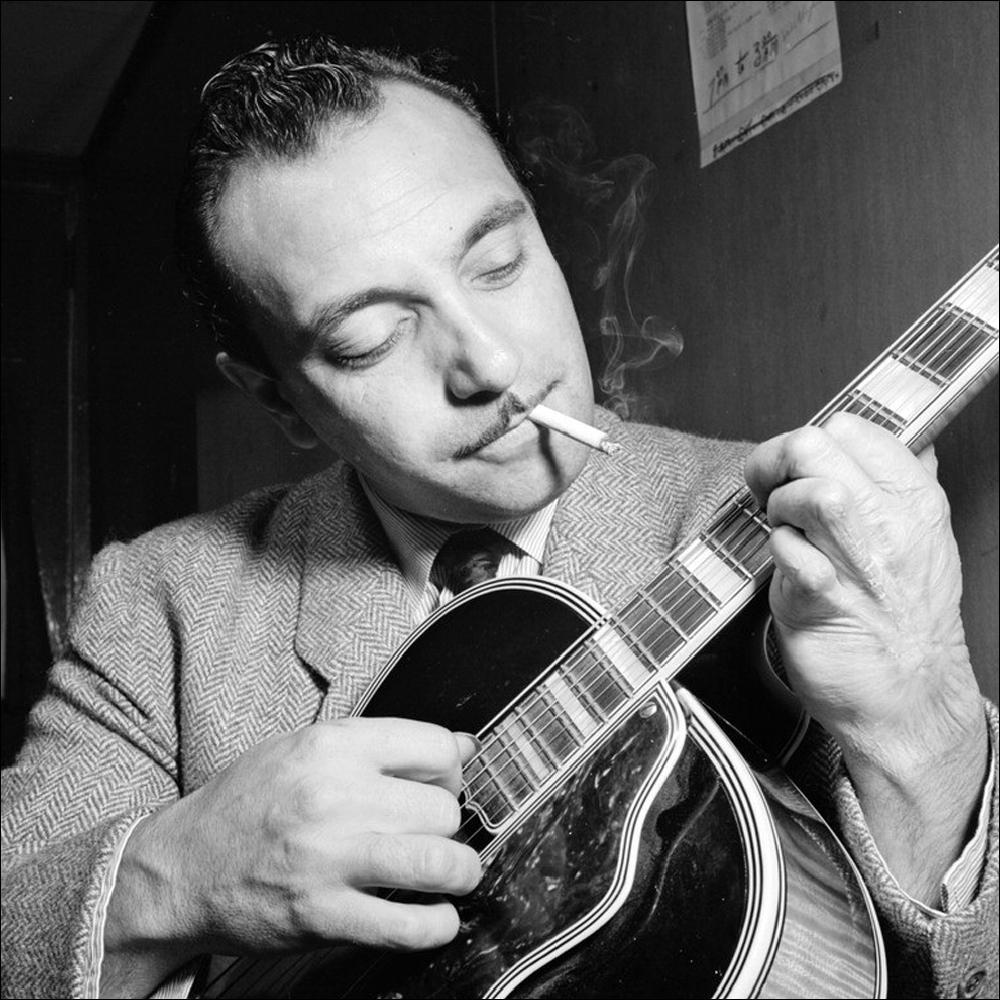
Django Reinhardt
Preface
Ethnic pre-convictions in our own minds repeatedly create the perception of the “other” as foreign. In order to effectively combat racist resentments, social framework conditions must be created that ensure inclusion and participation. Society still focuses on social problems and does not pay enough attention to their cultural diversity. The recognition and respectful consideration of the rich art and culture of the Sinti and Roma and Spanish Gitanos promote the development of a democratic society in an extraordinary way, in which the coexistence of people is determined by mutual dignity and mutual respect. A quote from the Central Council of German Sinti and Roma sums up: “Living together with all people, being in conversation with one another, being respected as a full-fledged person, recognizing art, culture, poetry and music as special values, that is what it is great enrichment that we bring to society. “”
A common characteristic of this captivating musical culture is that it emerged from a strong family bond. Completely different to the academic didactics of classical music, jazz and pop, the musical legacy is usually passed on from father to son, from uncle to nephew, etc. without it being noted down in writing. Within the clan, the bands exist more or less as a family business in which sons and daughters go on tour with their father and cousins and perfect their play due to the intense musical experience. This tradition is still common in the most varied of styles today: whether in Spanish flamenco, Bulgarian manea, Franco-German manouche jazz, Turkish çiftetelli or Hungarian csárdás. In the 20th century, the influences of various European musical styles flowed together in “jazz manouche” or “gypsy jazz”. Its most famous representative was the French Sinto Django Reinhardt.
The djangoO festivals pay homage to the unconventional mixes of these rich musical non-academic art forms in 5 European countries within 5 years for one week each. DjangoO presents itself varied and innovative in its opening year 2021, in which the festival guests can expect Andalusian flamenco, unorthodox swing fusions and virtuoso musical Balkan wildfire at the highest level with artists of the absolute world class.
Look forward to a kaleidoscope of innovative singers as well as guitar and violin virtuosos from all over Europe and exciting newcomers! The visitors can excpect to listen to a excellent program, even if they might not know the artist. Thanks to all the sponsors and artists. The future will be thrilling.
(Alexander Diepold – Walter Abt)
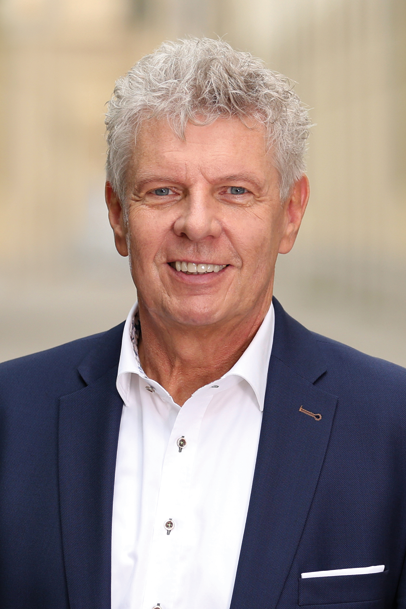
Dieter Reiter
Lord Mayor of the City of Munich
Greetings
The Sinti and Roma living in Munich are an integral, diverse and natural part of urban society. However, the centurylong common history here was also marked for a long time by exclusion, discrimination and persecution.
Today, Sinti and Roma are recognized as citizens with equal rights, but there are still many clichés, discrimination and exclusion. A recently presented representative study on prejudice-motivated crime in the state capital Munich showed that the Sinti and Roma living in Munich are a group particularly affected by exclusion and discrimination. This is still expressed in the form of structural disadvantages in areas such as education, health or housing.
In order to get closer to the goal of equal participation and to effectively combat racist resentments, different paths have to be taken. For example, the state capital of Munich has launched a campaign with interviews and postcard motifs under the title “I am Munich – I am Sinto and Roma. The aim of the campaign is to make the diversity of Munich’s Sinti and Roma and their deep roots in Munich’s urban society visible.
And especially the recognition and respectful consideration of the living abundance of art and culture of the Sinti and Roma and the Spanish Gitanos is a way to promote a coexistence and dialogue based on dignity and mutual respect. A prime example of this is the “djangoO” project, which enables Sinti and Roma from different European countries to present their extraordinary musical abilities in an impressive way.
Films and lectures on the genesis of the respective musical streams, music workshops and top-class concerts offer a unique opportunity to get to know this extraordinarily diverse culture more intensively. Therefore, I am very happy that the first of five one-week “djangoO” festivals with world-famous musicians is taking place in Munich and that there will be an encounter between flamenco, gypsy swing and manouche , Classical music, world music and jazz between the first concert in the Old Town Hall and the final concert in the foyer of the Bavarian State Parliament.
The “djangoO” festival from October 16 to 21, 2021 is a great addition to the culture and music city of Munich. And I am sure that by conveying cultural diversity it will set an important example for equal participation and a change of perspective for society as a whole. With this in mind, I hope all musicians and all festival visitors will enjoy the great musical legacy of the Sinti and Roma and the Spanish gitanos!
(Dieter Reiter)
Workshops
for active and passive participants
FLAMENCO | Monday, October 18, 2021
Guitar with El Chonico | 3 p.m. – 6 p.m.
Dance with Vanesa Montero & Paco Fernandez | 6 p.m. – 9 p.m.
Joscho Stephan | Tuesday, October 19, 2021 | 3 p.m. – 6 p.m.
Bobby Falta | Wednesday, October 20, 2021 | 3 p.m. – 5.30 p.m.
Diknu Schneeberger | Thursday, October 21, 2021 | 3 p.m. – 5.30 p.m.
Prices | 40€ 45 Min. One-to-one tuition with 1 instructor | 30€ 90 min. Group lesson | 15€ guest student | Workshop weekly pass: 90€ active, 45€ passive
Prices dance workshop with Vanesa Montero & Paco Fernandez | Active participation in group lessons: 30€ 90 min. | 60€ 180 min. | 15€ guest student
Registration for all workshops | until October 15, 2021: info@djangoo.eu
Program
Saturday, October 16, 2021
FOCUS SERBIA
Festival information daily program
Kulturbüro Madhouse, Landwehrstraße 43, 80336 München
Saturday, October 16, 2021
11 a.m. - 12 a.m.
Concert
Saal im Alten Rathaus, Marienplatz 15, 80331 München
Saturday, October 16, 2021
7 p.m.
28€ | €13 reduced | €8 Munich Pass and Madhouse | Presale muenchenticket | Box office
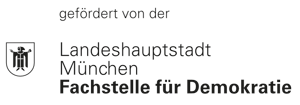
BRANKO BAKO JOVANOVIC – BALKAN GYPSY
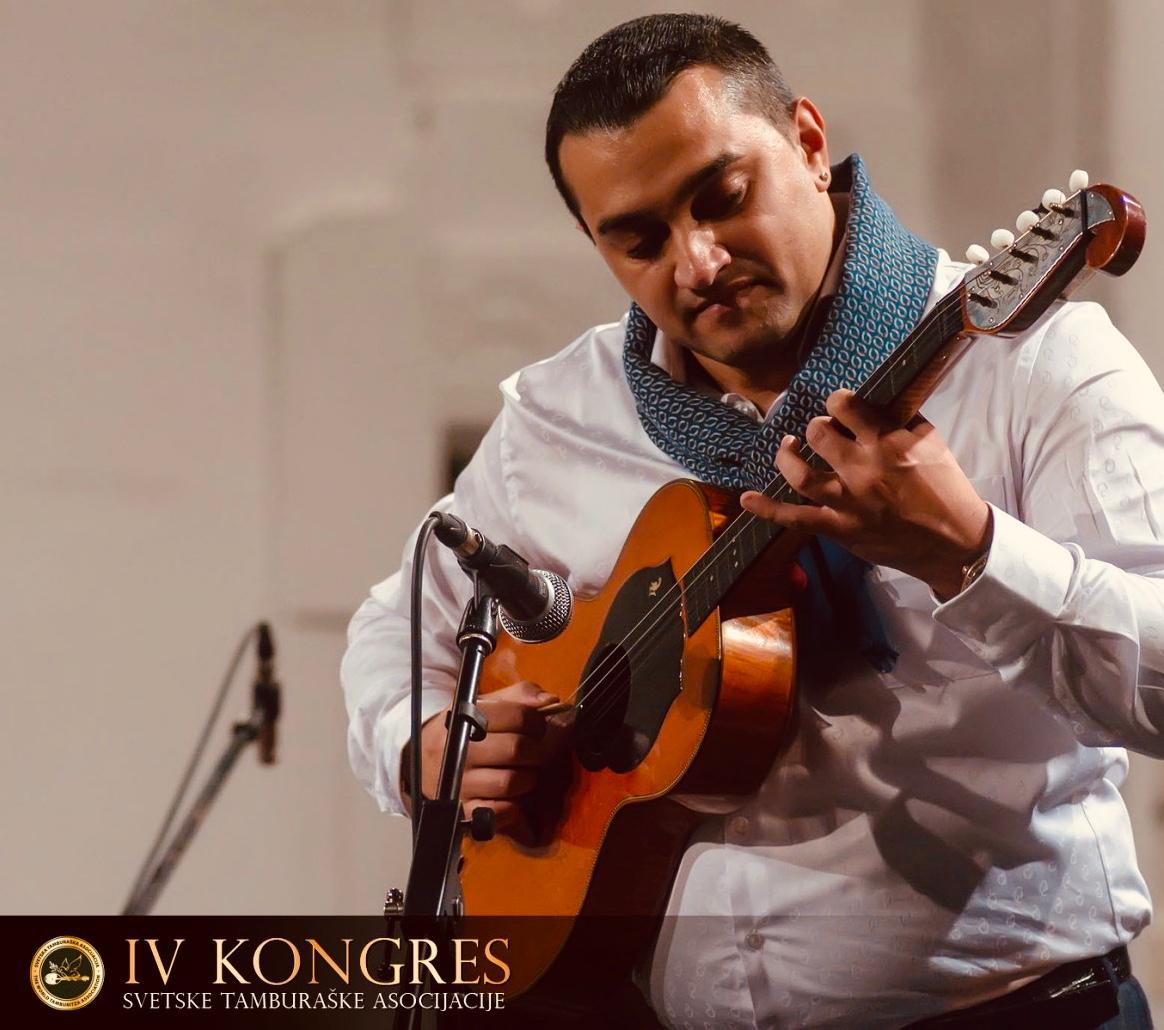
Branko Bako Jovanovic, born in Vienna in 1988, is a young, extremely talented musician, who has made a name for himself as one of the most important virtuosos on the tamburica, a 5-string South Slavic guitar mandolin, far beyond the borders of Balkan music. As a 12-year-old boy he showed great interest in playing this lute instrument. His talent rapidly developed into one of the most sought-after soloists in Serbia. With his ensemble he is a welcomed guest at many European festivals as an outstanding representative of Balkan gypsy music. Branko Bako Jovanovic is unique in his virtuoso interpretation of the tamburica and cultivates his own characteristic, distinctive musical style.
Sunday, October 17, 2021
FOCUS SPAIN
Festival information daily program
Kulturbüro Madhouse, Landwehrstraße 43, 80336 München
Sunday, October 17, 2021
11 a.m. - 12 a.m.
Concert
Kulturzentrum Gasteig, Carl-Orff-Saal, Rosenheimer Straße 5, 81667 München
Sunday, October 17, 2021
8 p.m.
37€ Category 1 | 24€ Cat. 2 | 17€ reduced | €9 Munich Pass and Madhouse | Presale muenchenticket | Box office
With the kind support of

EL AMOR BRUJO – FLAMENCO PURO
with Chonchi Heredia, cante; Munich Guitars / Head Walter Abt; Antonio Heredia, git; Paco Fernandez, dance; Vanesa Montero, dance; Sara Heredia, cante
 Chonchi Heredia
Chonchi Heredia
Chonchi Heredia is one of the most sought-after voices in the world of flamenco. Her family comes from the Sacromonte in Granada. Her brilliant career began as a young talent in the flamenco tablaos in Albaizyn, Granada. In Madrid, the most famous flamenco artists asked to make sound recordings with her. She accompanied world-famous dancers such as Joaquín Cortés, Juana Amaya or Antonio Canales to the most important dance festivals. Her vocal qualities inspire the most modern ensembles in Spain such as those of Jorge Pardo, Chano Domínguez, Miguel Bosé, Los Rodríguez and Estopa. Last but not least, the outstanding personality of flamenco – Paco de Lucía – brought Chonchi into his ensemble to accompany him as the main singer on his world tours. In the concert, Chonchi Heredia sings the 4 Canciones from Manuel de Fallas El Amor Brujo – Magic Love, which Walter Abt has embedded as fragments in his flamenco composition De Falla Concerto – accompanied by the Munich Guitars with the soloists Walter Abt and Ken Weinzierl at the Guitar.
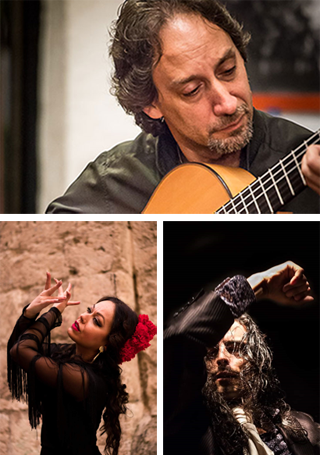 Antonio Heredia (El Chonico), Paco Fernández, Vanesa Montero and Sara Heredia
Antonio Heredia (El Chonico), Paco Fernández, Vanesa Montero and Sara Heredia
The ensemble of the Granada guitarist El Chonico, the dancer Paco Fernández, the dancer Vanesa Montero and Sara Heredia radiates Flamenco Puro. The excellent Spanish guitarist and singer Antonio Heredia, nicknamed “El Chonico”, is one of the most outstanding flamenco players in the world. He comes from the traditional artistic family Heredia, his grandmother was the famous flamenco singer La Faroaona. El Chonico’s style is inextricably linked to his origins: he was born in the famous Flamenco district of “Sacromonte”. His wife is joining him on stage – the singer Sara Heredia, -Chonchi’s sister, one of the currently deepest voices of the Cante Jondo. “Flamenco is a dance performed with the face, the hands and the body”, postulates Paco Fernandez from Madrid, one of the most famous flamenco teachers in Spain and the best interpreter of the very own Iberian art. His counterpart and congenial connection is Vanesa Montero, currently one of the most sought-after dancers in Andalusia. She impresses with her fiery temperament, her high sensitivity and her expressive power. El Chonico and his ensemble will delight flamenco fans on this Spanish evening!
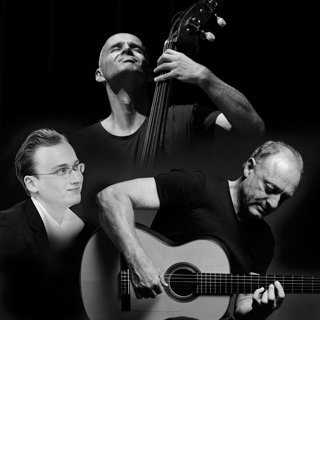 Munich Guitars, direction Walter Abt
Munich Guitars, direction Walter Abt
Soloists: Walter Abt, Ken Weinzierl (guitar), Peter Cudek (double bass)
The musical language of the trio of two acoustic guitars and double bass is dedicated to the Moorish heritage of Andalusia. Together with his two colleagues Ken Weinzierl (guitar) and Peter Cudek (double bass), Walter Abt presents his own compositions, that pay homage to flamenco in the sound language of Paco de Lucía and Manuel de Fallas. Fragments from Manuel de Falla’s El Amor Brujo are edited into 4 pieces, which Abt has specially prepared for the djangoO festival, that cause a sensation to the rhythm of the fandango, the bulerías and the seguiriyas. The trio performs supported by Chonchi Heredia, who accompanied Maestro Paco de Lucía on his world tours as the lead singer, and the fiery dancers Vanesa Montero and Paco Fernandez – the best of Granada’s flamenco artists. It is no coincidence that this ensemble combines the global worlds of flamenco and those of jazz and classical music. This fusion is one of a kind and proves that flamenco can also reinvent itself again and again outside of Spain.
The newcomer in Abt’s ensemble is the double bass player Peter Cudek. In Bratislava, Slovakia, he received training on the electric bass, switched to the double bass and completed classical studies at the conservatory in his hometown and in Munich. After successful lessons with the world-famous jazz bassist Ron Carter in New York, recordings and concert tours with the elite of European jazz made him internationally known.
Walter Abt Homepage Peter Cudek Homepage Las puertas de Garachico on Youtube
Monday, October 18, 2021
FOCUS SPAIN/FRANCE
Festival information daily program
Kulturbüro Madhouse, Landwehrstraße 43, 80336 München
Monday, October 18, 2021
11 a.m. - 12 a.m.
Workshop
Spanisches Kulturinstitut Cervantes, Alfons-Goppel-Straße 7, 80539 München
Monday, October 18, 2021
3 p.m. - 6 p.m.
40€ 45 min. One-to-one tuition with 1 instructor | 30€ 90 min. Group lesson | 15€ guest student | Workshop weekly pass: 90€ active, 45€ passive | Registration until October 15, 2021: info@djangoo.eu
WORKSHOP FLAMENCO GUITAR
with El Chonico, Granada
Workshop
Spanisches Kulturinstitut Cervantes, Alfons-Goppel-Straße 7, 80539 München
Monday, October 18, 2021
6 p.m. - 9 p.m.
Active participation in group lessons: 30€ 90 min. | 60€ 180 min. | Registration until October 15, 2021: info@djangoo.eu
WORKSHOP FLAMENCO DANCE
with Vanesa Montero & Paco Fernandez
Concert
Kulturzentrum Gasteig, Carl-Orff-Saal, Rosenheimer Straße 5, 81667 München
Monday, October 18, 2021
8 p.m.
37€ Category 1 | 24€ Cat. 2 | 17€ reduced | €9 Munich Pass and Madhouse | Presale muenchenticket | Box office
HOMMAGE A DJANGO – Biréli Lagrène & Joscho Stephan
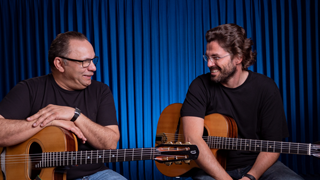
As the “legitimate successor of Django Reinhardt”, Biréli Lagrène has long since stepped out of the footsteps of the great gypsy hero Reinhardt – among other things because he is more dedicated to jazz, folk and modern styles of music. The list of those who worked with Lagrène, who lives in France, is now long. To name just a few examples: Richard Galliano, Herbie Hancock to Al Di Meola and John McLaughlin, Larry Coryell to Billy Cobham. Celebrated as a child prodigy and Django reincarnation, Biréli always found his way back to his musical roots after trips to bebop and jazz rock – the gipsy swing. Joscho Stephan also shapes modern gypsy swing with his play. He knows like no other how to stand out from the multitude of current Gypsy Swing adaptations by combining Gypsy Swing with Latin, Classical and Pop in addition to the many interpretations of the well-known classics of the genre. Joscho’s strengths as a creative visionary are evident here. And that inspires young and old concert audiences alike. On Joscho’s album “Guitar Heroes”, the first encounter with the gypsy jazz legend Biréli Lagrène took place. The two will dialogue their different musical accents in a common musical language. One thing is certain: their Gypsy Swing roots won’t be denied.
Tuesday, October 19, 2021
FOCUS GERMANY/SPAIN
Festival information daily program
Kulturbüro Madhouse, Landwehrstraße 43, 80336 München
Tuesday, October 19, 2021
11 a.m. - 12 a.m.
Workshop
Spanisches Kulturinstitut Cervantes, Alfons-Goppel-Straße 7, 80539 München
Tuesday, October 19, 2021
3 p.m. - 6 p.m.
40€ 45 min. One-to-one tuition with 1 instructor | 30€ 90 min. Group lesson | 15€ guest student | Workshop weekly pass: 90€ active, 45€ passive | Registration until October 15, 2021: info@djangoo.eu
WORKSHOP WITH JOSCHO STEPHAN
for active and passive participants
Movie
Spanisches Kulturinstitut Cervantes, Alfons-Goppel-Straße 7, 80539 München
Tuesday, October 19, 2021
6 p.m. - 7 p.m.
Film presentation and subsequent symposium: 2€ entry (free for workshop participants)
LA CHANA – MY LIFE, A DANCE
The talented flamenco dancer Antonia Santiago `La Chana‘ Amador returns to the stage after thirty years to give one last seated performance. The film documents the life of the dancer on and behind the stage, and explains why she suddenly disappeared from the scene at the peak of her career….
Director: Lucija Stojevic
Spain 2016 · german subtitles · 61 minutes
In dialogue - culture and social affairs, history and education
Spanisches Kulturinstitut Cervantes, Alfons-Goppel-Straße 7, 80539 München
Tuesday, October 19, 2021
7 p.m. - 7:30 p.m.
FOCUS SPAIN
Granada as a model city for successful integration
Concert
Künstlerhaus, Lenbachplatz 8, 80333 München
Tuesday, October 19, 2021
8 p.m.
28€ | €13 reduced | €8 Munich Pass and Madhouse | Presale muenchenticket | Box office
JAZZ MANOUCHE
Bobby & Lancy Falta and Peter Bockius
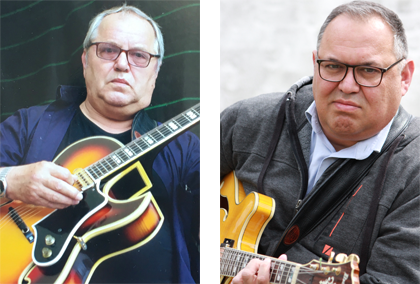 Bobby und Lancy Falta
Bobby und Lancy Falta
“I feel like a Sinto who plays more modernly than traditionalists expect”, says Bobby Falta, who caused a sensation as solo guitarist with the Schnuckenack-Reinhardt quintet as early as the 1960s. After this era he took the first step towards a different kind of music away from traditional swing. Contrary to the diction “A Sinto has to play like Django”, modern jazz flowed through its 6 strings, inspired by Wes Montgomery and Barney Kessel. His son Lancy was practically born with musical talent. At the age of 10 he learned to play the guitar from his father. His high level of playing and his sophisticated technique are also appreciated by the most important European and North American jazz musicians. As early as 1994, father and son were awarded the City of Memmingen’s Culture Prize for their innovative music.
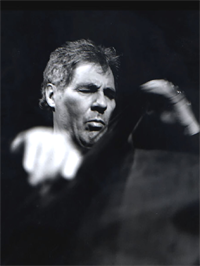 Peter Bockius
Peter Bockius
Moved from Freiburg to Munich after completing his studies, he quickly gained a reputation as one of the leading bass players in Europe. His colleagues all appreciate him for his terrific walking on the bass, which ticks as precisely as a Swiss clockwork.
Zipflo Reinhardt & Joe Bawelino
Zipflo Reinhardt, whose prominent ancestor Django Reinhardt once brought jazz to Europe, is one of the most modern jazz violinists of his era. With him, on the one hand, the various stylistic elements merge into a new captivating variety and, on the other hand, he presents well-known jazz standards in a new musical guise. He is accompanied by his long-time musical friend Joe Bawelino, who, according to the “Oreos Collection Jazz”, represents the most swinging synthesis of Django heritage and Charlie Christian’s school in the guitarist Manouche tradition.
Wednesday, October 20, 2021
FOCUS FRANCE/AUSTRIA
Festival information daily program
Kulturbüro Madhouse, Landwehrstraße 43, 80336 München
Wednesday, October 20, 2021
11 a.m. - 12 a.m.
Workshop
Spanisches Kulturinstitut Cervantes, Alfons-Goppel-Straße 7, 80539 München
Wednesday, October 20, 2021
3 p.m. - 5:30 p.m.
40€ 45 min. One-to-one tuition with 1 instructor | 30€ 90 min. Group lesson | 15€ guest student | Workshop weekly pass: 90€ active, 45€ passive | Registration until October 15, 2021: info@djangoo.eu
WORKSHOP WITH BOBBY FALTA
for active and passive participants
Movie
Spanisches Kulturinstitut Cervantes, Alfons-Goppel-Straße 7, 80539 München
Wednesday, October 20, 2021
5:30 p.m. -7 p.m.
Film presentation and subsequent symposium: 2€ entry (free for workshop participants)
EXTRACTS FROM: DJANGO – A LIFE FOR MUSIC
In Paris in 1943, the jazz musician Django Reinhardt feels safe. Although he belongs to the Sinti, his swing music is popular with the Nazis. But because he doesn’t want to go on tour in Germany, he has to flee to Switzerland. But this does not go unnoticed for long …
Director: Étienne Comar
France 2017 · 117 min
In dialogue - culture and social affairs, history and education
Kulturbüro Madhouse, Landwehrstraße 43, 80336 München
Wednesday, October 20, 2021
7 p.m. - 7:30 p.m.
Discussion about the film content
Concert
Maximilianeum Bürklein Halle, Max-Planck-Straße 1, 81675 München
Wednesday, October 20, 2021
8 p.m.
30€ | 14€ reduced | 9€ Munich Pass and Madhouse | Presale muenchenticket | Box office
Diknu Schneeberger Trio
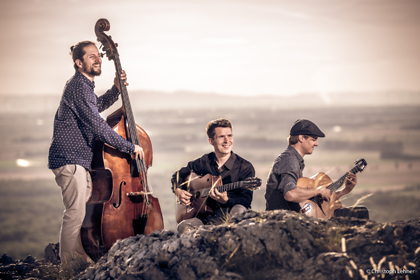 The Diknu Schneeberger Trio is one of the best gypsy jazz bands in the world. The trio from Vienna enchants its listeners in a very special way with three string instruments. Diknu writes most of the compositions himself and thus brings originality to the program. Their varied grooves and fiery as well as sensitive melodies radiate joie de vivre and positive energy – a real listening pleasure! In 2020 there will be two new calibers in Diknus Trio. Julian Wohlmuth, longtime friend of Diknu, cheers the band on with his driving rhythm guitar and at the same time adds joy, enthusiasm and unbelievable freshness to the sounds of the formation with relaxed cheerfulness. The double bass player Martin Heinzle brings the earthy sound to the trio. With virtuosity and a keen sense for the tone, he shines when soloing as well as when accompanying and brings momentum to the band with his fine grooves.
The Diknu Schneeberger Trio is one of the best gypsy jazz bands in the world. The trio from Vienna enchants its listeners in a very special way with three string instruments. Diknu writes most of the compositions himself and thus brings originality to the program. Their varied grooves and fiery as well as sensitive melodies radiate joie de vivre and positive energy – a real listening pleasure! In 2020 there will be two new calibers in Diknus Trio. Julian Wohlmuth, longtime friend of Diknu, cheers the band on with his driving rhythm guitar and at the same time adds joy, enthusiasm and unbelievable freshness to the sounds of the formation with relaxed cheerfulness. The double bass player Martin Heinzle brings the earthy sound to the trio. With virtuosity and a keen sense for the tone, he shines when soloing as well as when accompanying and brings momentum to the band with his fine grooves.
Thursday, October 21, 2021
FOCUS EUROPE
Festival information daily program
Kulturbüro Madhouse, Landwehrstraße 43, 80336 München
Thursday, October 21, 2021
11 a.m. - 12 a.m.
Workshop
Spanisches Kulturinstitut Cervantes, Alfons-Goppel-Straße 7, 80539 München
Thursday, October 21, 2021
3 p.m. - 5:30 p.m.
40€ 45 min. One-to-one tuition with 1 instructor | 30€ 90 min. Group lesson | 15€ guest student | Workshop weekly pass: 90€ active, 45€ passive | Registration until October 15, 2021: info@djangoo.eu
WORKSHOP WITH DIKNU SCHNEEBERGER
for active and passive participants
In dialogue - culture and social affairs, history and education
Spanisches Kulturinstitut Cervantes, Alfons-Goppel-Straße 7, 80539 München
Thursday, October 21, 2021
5:30 p.m. -7 p.m.
SYMPOSIUM
Music and culture as an instrument for empowerment, participation and dialogue
PARTICIPANTS IN DISCUSSION:
MdEP Romeo Franz
The Greens / EFA Group in the European Parliament
Alexander Diepold
Madhouse Munich
“What has been practiced as a matter of course in music for centuries, runs into problems in politics. How can we use music and culture as an instrument for inclusion and participation of Sinti and Roma in Europe? A discussion evening on the role of music and culture in the dialogue between minority and majority, as empowerment for young people, as an opportunity for education and as a platform to promote memory work on the one hand and to fight against antigypsyism on the other.”
Concert
Spanisches Kulturinstitut Cervantes, Alfons-Goppel-Straße 7, 80539 München
Thursday, October 21, 2021
7 p.m. (with limited public participation)
FINAL CONCERT BY PARTICIPANTS WITH LECTURERS
